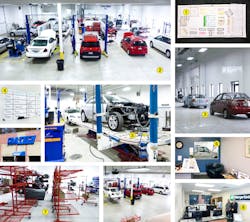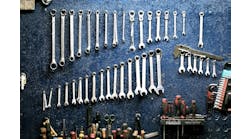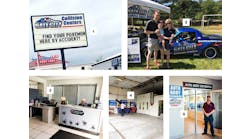Photo courtesy Car-Tech Collision
SHOP: Car-Tech Collision LOCATION: Green, Ohio OWNER: Jason Rettberg
SIZE: 13,600 square feet STAFF: 12 AVERAGE MONTHLY CAR COUNT: 50 ANNUAL REVENUE: $1.6 million
“I’ve always wanted to have a system where the cars move like a racetrack all the way around,” owner Jason Rettberg says.
After an accidental fire in an adjoining business displaced the Car-Tech Collision team for five months, Rettberg saw the opportunity for a new beginning. The team moved into a 13,600-square-foot structure with dirt floors in 2008, providing Rettberg the blank canvas he needed to turn the two-lane system he had been designing since 2000 into a reality. “It was just nice to be able to take it from scratch like that and put drains where I wanted and build walls where I wanted,” says Rettberg.
1) The idea for this system has been with Rettberg for a long time. He created a poster board in 2000 that shows his idea for the two-lane systems. The original layout was then refined to fit the space of the current shop. Laying everything out on the board helped Rettberg check turning radiuses and find potential bottlenecks when he was imagining the workflow.
2) When cars are first dropped off in the morning, the team starts the process of entering cars into their designated “lanes.” The smaller jobs, the ones that are able to be inputted into the system the quickest, usually are entered first. The team gets a cart, creates an RO, tags the keys of the vehicle, disassembles, writes the estimate and then gets the car into production. They continue this process all day long.
3) The two-lane system begins in the disassembly department, which is also the step that inspired Rettberg to begin using this system. “I remember being a technician and it just didn’t make sense to me that we wouldn’t begin with a proper disassembly,” he says. As a technician, he had been frustrated with the supplement rate. Rettberg never understood why managers would put cars into production and create locked estimates without knowing if there was additional damage. His system of performing a full disassemble helps avoid that problem.
4) In order for this process to work, a lot of planning needs to take place. There are dry erase boards in the body, paint and reassembly areas. Once a job is done, it is crossed off the board and transferred to the next department.
5) There is a structural zone in the middle of the shop. The shop layout was built for two frame racks, and currently has one Chisum Freedom two-tower 360 VHT 10-ton frame rack with eventual plans to put in another. The National Auto Tools lifts that are in front of the structural zone are used to get cars in the air, unloading the suspension, and then pushing vehicles onto the rack when mechanical components are removed or access is needed to repair and replace parts. All of the structural, freeload suspension and mechanical work can be done, and then it can go straight over to body.
6) Rettberg installed a large picture window looking from the lobby into the shop. At Car-Tech Collision, it’s important that the customers are able to see the shop floor and check on the progress of their cars at all times, Rettberg says.
7) Since the customers can see into the shop whenever they want, keeping up the shop’s appearance is a top priority. “I’m kind of a freak about the clean part,” he says, which could be why Car-Tech Collision has a full-time employee to keep the shop clean. Along with an upstairs area for extra storage, the parts carts help keep everything in the shop organized and off the floor.
8) Connected to the shop is an onsite Enterprise office that can be accessed through a hallway off the lobby.
Do you have a stand-out building, shop space, office or lobby? Submit your info to [email protected] and we may contact you for a full write-up on the view in your shop.


